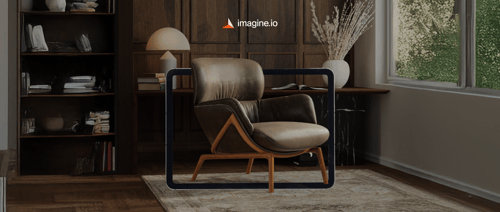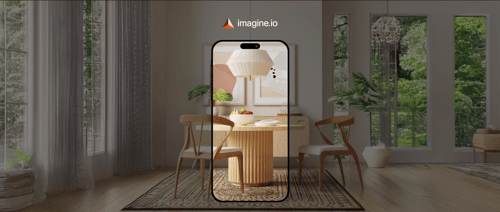When we talk about sustainability today, it’s not just about recycling bins or switching to LED lights. It’s about rethinking the entire product lifecycle—starting with how we design and prototype the things we make.
That’s where digital twins and virtual prototyping are rewriting the rulebook. These technologies allow brands to simulate, test, and optimize their products entirely in a digital space—long before physical production begins. The result? Less waste, fewer emissions, and faster go-to-market timelines.
And if you're in product innovation, design, or executive leadership, this matters—both environmentally and operationally. Let’s explore exactly how this works—and why companies leaning into digital twins now are setting themselves up for long-term sustainability and success.
Get the latest updates straight to your inbox.
By clicking sign up you'll receive occasional emails from imagine.io. You always have the choice to unsubscribe within every email you receive.
What exactly is a Digital Twin?

Think of a digital twin as a living, interactive virtual replica of a physical product or system. It mirrors the real-world version in every functional and visual detail, pulling in real-time data and design changes to reflect how that product behaves under different scenarios.
Now combine that with virtual prototyping, where teams can test out colors, materials, construction, and interactions—all in 3D—before ever investing in a physical sample. This digital-first workflow doesn’t just make collaboration faster.
It reduces the need for physical prototypes, packaging, and shipping at every stage of development. At platforms like imagine.io, users can visually simulate complex products and experiences—down to lifestyle imagery and augmented reality views—with zero physical waste.
The Environmental Toll of Traditional Prototyping
In a traditional workflow, developing just one product variant might require the following:
- Multiple raw material runs
- Iterative factory builds
- International shipping of samples for review
- Waste from samples that never make it to market
Now, scale that across thousands of SKUs or seasonal drops. The environmental cost is significant.
As per capgemini’s study found that up to 70% of physical prototypes can be eliminated through virtual twin technologies—resulting in dramatic reductions in material waste and carbon emissions (Capgemini).
How Virtual Prototyping Slashes Environmental Impact
1. Drastically Reduces Physical Waste

Virtual prototyping allows your team to move through the entire design and testing process—without ever producing a single physical object. You can test structural feasibility, experiment with materials, and preview dozens (even hundreds) of variations in 3D. That means:
- No raw materials are wasted during development
- No physical samples need to be discarded
- No unnecessary packaging is created
Brands using platforms like imagine.io have reported 50–80% reductions in physical sample production within the first year. That’s not just good for the planet—it’s good for your bottom line.
2. Slashes Transportation Emissions
Shipping prototypes across departments, offices, or countries contributes heavily to carbon emissions—especially when done by air or freight. When your team, partners, or buyers can view, rotate, customize, and approve products in real time through high-fidelity 3D visuals or augmented reality, the need to ship anything physically is eliminated.
Because these digital assets are collaborative and cloud-based, feedback happens faster, and decisions are made quicker, accelerating production without the environmental toll of logistics.
3. Promotes Smarter, More Sustainable Design Choices
One of the biggest benefits of digital twins is their ability to simulate a product’s entire lifecycle—not just its appearance. You can test how different materials impact performance, durability, and environmental footprint. For example:
- Which material is more energy-efficient to produce?
- Which has a smaller shipping volume or lower weight?
- Which is easier to recycle or reuse after the product's end of life?
By making these decisions before production begins, teams can design with sustainability in mind, not as an afterthought. And because these insights are data-driven, they're easier to validate when aligning with ESG goals or reporting to stakeholders.
4. Accelerates Product Development with Fewer Resources

Time is a sustainability metric, too. The longer your product sits in development, the more resources you burn—more iterations, more reviews, more overhead. Virtual prototyping eliminates bottlenecks and accelerates timelines. Using AI-powered rendering and configuration tools, teams can:
- Preview multiple variants in minutes
- Get stakeholder approvals faster
- Make last-minute design changes without restarting the process
This means fewer delays, reduced use of internal resources, and faster market readiness—all without compromising on quality or innovation.
The Business Case for Sustainable Innovation
Sustainability isn’t just a corporate responsibility—it’s a competitive advantage. According to IBM’s Global Consumer Study, 49% of consumers have paid a premium (up to 59%) for products branded as sustainable or socially responsible (IBM Newsroom).
And internally, businesses are starting to see ESG as a growth strategy. An IBM Institute study found that 72% of executives view ESG initiatives as a revenue enabler, not just a cost center.
What does that mean for your business?
- Products developed with virtual tools don’t just help the planet—they resonate with the market.
- Efficiency gains can directly support both profit margins and sustainability goals.
- Brands that adapt now are far better positioned for future regulatory, consumer, and investor expectations.
Real Results from Real Brands
This isn't theory—it’s happening today.
- A global furniture brand replaced over 3,000 physical samples with virtual versions using imagine.io, cutting material waste by over 70% and accelerating approvals.
- A home décor manufacturer adopted virtual product imagery and configuration, enabling buyers to view every variant digitally—reducing showroom emissions and minimizing redundant inventory.
- Large retailers are now requiring digital-first vendor submissions to qualify for faster onboarding or higher placement priority.
These stories reflect a major shift: sustainability and digital innovation are no longer separate strategies—they’re becoming one and the same.
Conclusion: Sustainable by Design Starts with Digital
We’re past the point where sustainability can be bolted on at the end of the process. To meet the demands of today’s conscious consumers, regulations, and bottom-line goals, sustainability needs to start at the prototype level.
Digital twins and virtual prototyping offer a smart, scalable, and sustainable way forward—helping you bring products to market faster, leaner, and with less environmental impact.
At imagine.io, we help teams do just that—by providing a complete platform to visualize, customize, and launch products entirely digitally—from lifelike 3D renders to AR experiences. Ready to cut waste, accelerate innovation, and design with the planet in mind? Book a Demo and see how digital twins can transform your product development process.


.gif?width=1296&height=1296&name=Untitled%20design%20(8).gif)




.png?width=500&name=How%20to%20Add%20a%203D%20Product%20Configurator%20to%20Your%20WordPress%20Website%20(Complete%20B2B%20Guide).png)
















%20(1).png?width=500&name=Why%20Exploded%20Mattress%20Views%20Matter%20(And%20How%20to%20Generate%20Them)%20(1).png)
.png?width=500&name=Best%20Shopify%20Product%20Configurator_%20How%20to%20Choose%20the%20Right%20One%20(2).png)
.png?width=500&name=Why%20Exploded%20Mattress%20Views%20Matter%20(And%20How%20to%20Generate%20Them).png)



.png?width=500&name=Best%20Shopify%20Product%20Configurator_%20How%20to%20Choose%20the%20Right%20One%20(1).png)







.png?width=500&name=How%203D%20Rendering%20Can%20Make%20or%20Break%20Your%20Industrial%20Design%20Pitch%20(1).png)








%20with%20Digital%20Twins%20and%203D%20Visualization.png?width=500&name=Optimizing%20Your%20Digital%20Asset%20Management%20(DAM)%20with%20Digital%20Twins%20and%203D%20Visualization.png)




.png?width=500&name=Styling%20Home%20Decor%20for%202025_%20From%20Global%20Influences%20to%20Playful%20Personalization%20(1).png)
